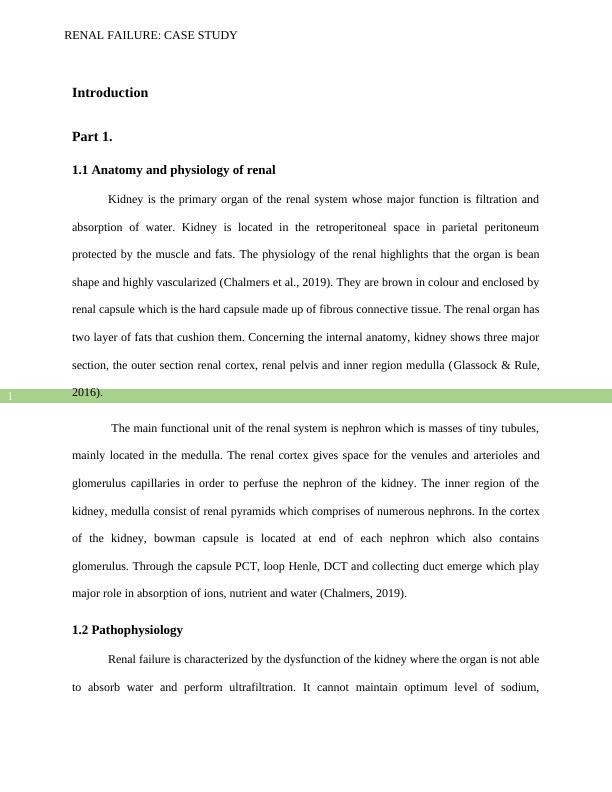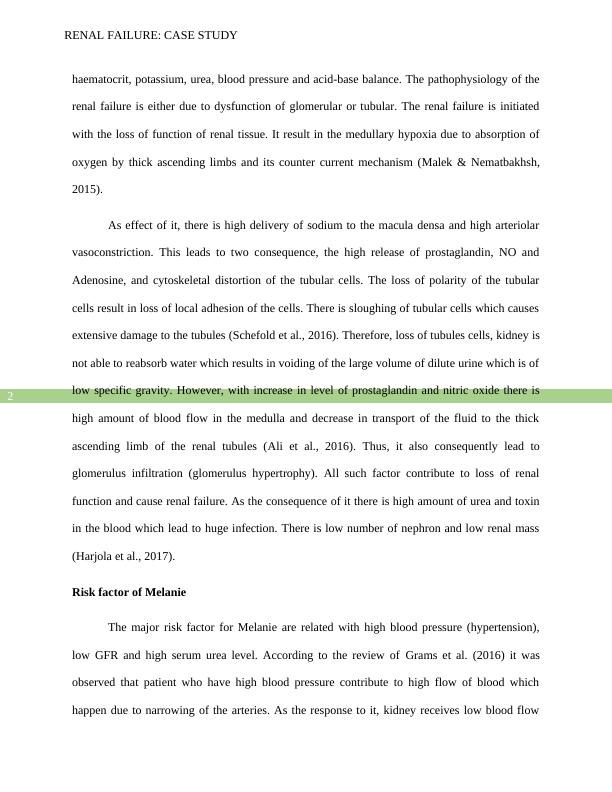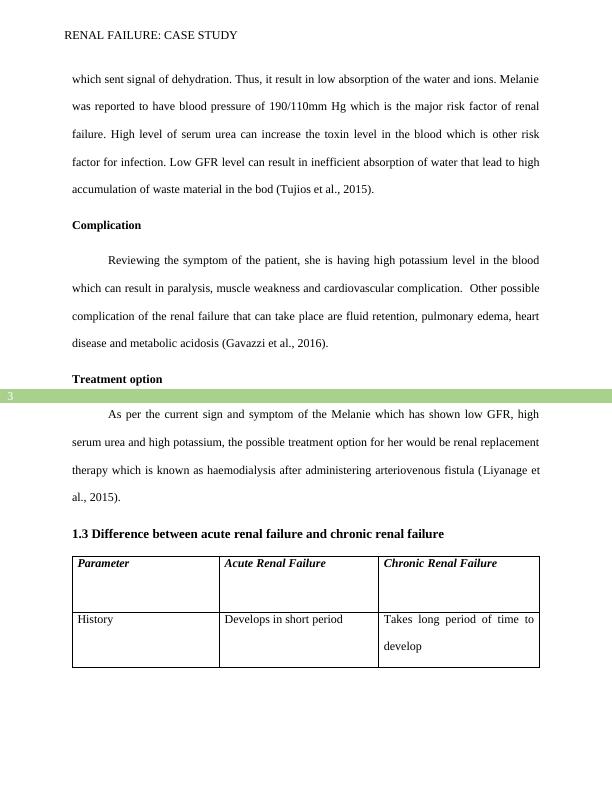Renal Failure: Case Study
Added on 2022-10-10
13 Pages3738 Words70 Views
Running head: RENAL FAILURE: CASE STUDY
RENAL FAILURE: CASE STUDY
Name of Student:
Name of University:
Author’s Note:
RENAL FAILURE: CASE STUDY
Name of Student:
Name of University:
Author’s Note:

RENAL FAILURE: CASE STUDY
1
Introduction
Part 1.
1.1 Anatomy and physiology of renal
Kidney is the primary organ of the renal system whose major function is filtration and
absorption of water. Kidney is located in the retroperitoneal space in parietal peritoneum
protected by the muscle and fats. The physiology of the renal highlights that the organ is bean
shape and highly vascularized (Chalmers et al., 2019). They are brown in colour and enclosed by
renal capsule which is the hard capsule made up of fibrous connective tissue. The renal organ has
two layer of fats that cushion them. Concerning the internal anatomy, kidney shows three major
section, the outer section renal cortex, renal pelvis and inner region medulla (Glassock & Rule,
2016).
The main functional unit of the renal system is nephron which is masses of tiny tubules,
mainly located in the medulla. The renal cortex gives space for the venules and arterioles and
glomerulus capillaries in order to perfuse the nephron of the kidney. The inner region of the
kidney, medulla consist of renal pyramids which comprises of numerous nephrons. In the cortex
of the kidney, bowman capsule is located at end of each nephron which also contains
glomerulus. Through the capsule PCT, loop Henle, DCT and collecting duct emerge which play
major role in absorption of ions, nutrient and water (Chalmers, 2019).
1.2 Pathophysiology
Renal failure is characterized by the dysfunction of the kidney where the organ is not able
to absorb water and perform ultrafiltration. It cannot maintain optimum level of sodium,
1
Introduction
Part 1.
1.1 Anatomy and physiology of renal
Kidney is the primary organ of the renal system whose major function is filtration and
absorption of water. Kidney is located in the retroperitoneal space in parietal peritoneum
protected by the muscle and fats. The physiology of the renal highlights that the organ is bean
shape and highly vascularized (Chalmers et al., 2019). They are brown in colour and enclosed by
renal capsule which is the hard capsule made up of fibrous connective tissue. The renal organ has
two layer of fats that cushion them. Concerning the internal anatomy, kidney shows three major
section, the outer section renal cortex, renal pelvis and inner region medulla (Glassock & Rule,
2016).
The main functional unit of the renal system is nephron which is masses of tiny tubules,
mainly located in the medulla. The renal cortex gives space for the venules and arterioles and
glomerulus capillaries in order to perfuse the nephron of the kidney. The inner region of the
kidney, medulla consist of renal pyramids which comprises of numerous nephrons. In the cortex
of the kidney, bowman capsule is located at end of each nephron which also contains
glomerulus. Through the capsule PCT, loop Henle, DCT and collecting duct emerge which play
major role in absorption of ions, nutrient and water (Chalmers, 2019).
1.2 Pathophysiology
Renal failure is characterized by the dysfunction of the kidney where the organ is not able
to absorb water and perform ultrafiltration. It cannot maintain optimum level of sodium,

RENAL FAILURE: CASE STUDY
2
haematocrit, potassium, urea, blood pressure and acid-base balance. The pathophysiology of the
renal failure is either due to dysfunction of glomerular or tubular. The renal failure is initiated
with the loss of function of renal tissue. It result in the medullary hypoxia due to absorption of
oxygen by thick ascending limbs and its counter current mechanism (Malek & Nematbakhsh,
2015).
As effect of it, there is high delivery of sodium to the macula densa and high arteriolar
vasoconstriction. This leads to two consequence, the high release of prostaglandin, NO and
Adenosine, and cytoskeletal distortion of the tubular cells. The loss of polarity of the tubular
cells result in loss of local adhesion of the cells. There is sloughing of tubular cells which causes
extensive damage to the tubules (Schefold et al., 2016). Therefore, loss of tubules cells, kidney is
not able to reabsorb water which results in voiding of the large volume of dilute urine which is of
low specific gravity. However, with increase in level of prostaglandin and nitric oxide there is
high amount of blood flow in the medulla and decrease in transport of the fluid to the thick
ascending limb of the renal tubules (Ali et al., 2016). Thus, it also consequently lead to
glomerulus infiltration (glomerulus hypertrophy). All such factor contribute to loss of renal
function and cause renal failure. As the consequence of it there is high amount of urea and toxin
in the blood which lead to huge infection. There is low number of nephron and low renal mass
(Harjola et al., 2017).
Risk factor of Melanie
The major risk factor for Melanie are related with high blood pressure (hypertension),
low GFR and high serum urea level. According to the review of Grams et al. (2016) it was
observed that patient who have high blood pressure contribute to high flow of blood which
happen due to narrowing of the arteries. As the response to it, kidney receives low blood flow
2
haematocrit, potassium, urea, blood pressure and acid-base balance. The pathophysiology of the
renal failure is either due to dysfunction of glomerular or tubular. The renal failure is initiated
with the loss of function of renal tissue. It result in the medullary hypoxia due to absorption of
oxygen by thick ascending limbs and its counter current mechanism (Malek & Nematbakhsh,
2015).
As effect of it, there is high delivery of sodium to the macula densa and high arteriolar
vasoconstriction. This leads to two consequence, the high release of prostaglandin, NO and
Adenosine, and cytoskeletal distortion of the tubular cells. The loss of polarity of the tubular
cells result in loss of local adhesion of the cells. There is sloughing of tubular cells which causes
extensive damage to the tubules (Schefold et al., 2016). Therefore, loss of tubules cells, kidney is
not able to reabsorb water which results in voiding of the large volume of dilute urine which is of
low specific gravity. However, with increase in level of prostaglandin and nitric oxide there is
high amount of blood flow in the medulla and decrease in transport of the fluid to the thick
ascending limb of the renal tubules (Ali et al., 2016). Thus, it also consequently lead to
glomerulus infiltration (glomerulus hypertrophy). All such factor contribute to loss of renal
function and cause renal failure. As the consequence of it there is high amount of urea and toxin
in the blood which lead to huge infection. There is low number of nephron and low renal mass
(Harjola et al., 2017).
Risk factor of Melanie
The major risk factor for Melanie are related with high blood pressure (hypertension),
low GFR and high serum urea level. According to the review of Grams et al. (2016) it was
observed that patient who have high blood pressure contribute to high flow of blood which
happen due to narrowing of the arteries. As the response to it, kidney receives low blood flow

RENAL FAILURE: CASE STUDY
3
which sent signal of dehydration. Thus, it result in low absorption of the water and ions. Melanie
was reported to have blood pressure of 190/110mm Hg which is the major risk factor of renal
failure. High level of serum urea can increase the toxin level in the blood which is other risk
factor for infection. Low GFR level can result in inefficient absorption of water that lead to high
accumulation of waste material in the bod (Tujios et al., 2015).
Complication
Reviewing the symptom of the patient, she is having high potassium level in the blood
which can result in paralysis, muscle weakness and cardiovascular complication. Other possible
complication of the renal failure that can take place are fluid retention, pulmonary edema, heart
disease and metabolic acidosis (Gavazzi et al., 2016).
Treatment option
As per the current sign and symptom of the Melanie which has shown low GFR, high
serum urea and high potassium, the possible treatment option for her would be renal replacement
therapy which is known as haemodialysis after administering arteriovenous fistula (Liyanage et
al., 2015).
1.3 Difference between acute renal failure and chronic renal failure
Parameter Acute Renal Failure Chronic Renal Failure
History Develops in short period Takes long period of time to
develop
3
which sent signal of dehydration. Thus, it result in low absorption of the water and ions. Melanie
was reported to have blood pressure of 190/110mm Hg which is the major risk factor of renal
failure. High level of serum urea can increase the toxin level in the blood which is other risk
factor for infection. Low GFR level can result in inefficient absorption of water that lead to high
accumulation of waste material in the bod (Tujios et al., 2015).
Complication
Reviewing the symptom of the patient, she is having high potassium level in the blood
which can result in paralysis, muscle weakness and cardiovascular complication. Other possible
complication of the renal failure that can take place are fluid retention, pulmonary edema, heart
disease and metabolic acidosis (Gavazzi et al., 2016).
Treatment option
As per the current sign and symptom of the Melanie which has shown low GFR, high
serum urea and high potassium, the possible treatment option for her would be renal replacement
therapy which is known as haemodialysis after administering arteriovenous fistula (Liyanage et
al., 2015).
1.3 Difference between acute renal failure and chronic renal failure
Parameter Acute Renal Failure Chronic Renal Failure
History Develops in short period Takes long period of time to
develop

End of preview
Want to access all the pages? Upload your documents or become a member.
Related Documents
Pathophysiology of Renal and Chronic Renal Failurelg...
|14
|3632
|446
Healthcare. Student's Name. Institutional Affiliation. lg...
|12
|3137
|1
Chronic Renal Failure: Pathophysiology, Risk Factors, and Treatmentlg...
|12
|3093
|441
Nursing: A Case study 2022lg...
|10
|2846
|16
Renal Anatomy and Physiology (PDF)lg...
|14
|3386
|230
Water Diuresis and Urinalysis: Experiment and Resultslg...
|14
|2935
|460
